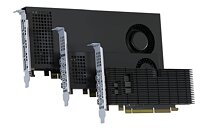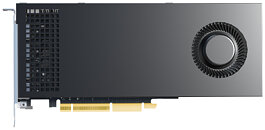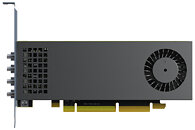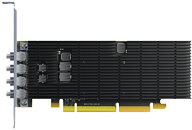Video technology innovator Matrox Video today announced the launch of its new Matrox LUMA series of graphics cards with Intel Arc GPUs. The series consists of three single-slot cards: the LUMA A310, a low-profile fanless card; the LUMA A310F, a low-profile fanned card; and the LUMA A380, a full-sized fanned card.
Matrox Video developed the LUMA range to satisfy significant demand in the mainstream graphics market for driving multiple screens, with a balance between size, reliability, and performance for different applications. The new LUMA series is aimed at high-reliability and embedded PC applications in the medical, digital signage, control room, video wall, and industrial markets.




The LUMA A310 card is the only modern, low-profile fanless card. The fanless design offers quiet operation and eliminates a point of failure (the fan), thereby increasing reliability and extending the card's life. The LUMA A310 is the perfect choice for anyone needing a small card that fits in a small-form-factor system. Examples include industrial systems that sit on a table or behind a monitor, or surgical displays in an operating room, where there are stringent requirements for reliability.
The single-slot, low-profile LUMA A310F card is perfect for applications requiring more performance, such as in commercial gaming, where casino machines or arcade games require a small card and extra performance to drive video and 3D rendering. Another application is in the retail space to drive multimonitor graphics, such as digital signage and digital menu boards.
The full-sized, single-slot LUMA A380 card packs even more performance and more GDDR6 (6 GB versus 4 GB) than the other LUMA models. In the health care market, the LUMA A380 can power volumetric rendering in medical workstations. In transportation and aviation applications, it delivers multimonitor graphics and video with the best possible performance. In federal and defense applications, such as live operation control rooms and PC-based simulators, users can rely on it to control medium to large video display walls showing multiple video feeds.
All three LUMA cards have four outputs and can drive four 5K60 monitors. (All three can also drive up to 8K60 or 5K/120 displays but are limited to two outputs when doing so.) They are compatible with all the latest graphical capabilities, supporting DirectX 12 Ultimate, OpenGL 4.6, Vulkan 1.3, and OpenCL 3.0, as well as Intel's oneAPI for compute tasks and the Intel Distribution of OpenVINO toolkit for AI development. The cards also have class-leading codec engines that can both encode and decode H.264, H.265, VP9, and AV1.
Close collaboration with Intel made it possible for Matrox Video to customize certain features of the LUMA cards to address specific market needs and offer several qualities that are in high demand but aren't available elsewhere:
"The market has consistently looked to Matrox for high reliability, high stability, multi-head graphics cards with a long life-cycle," said Daniel Collin, senior product manager at Matrox Video. "With the LUMA family, we are pleased to continue satisfying these requirements in critical environments. Indeed, the alignment with Intel has resulted in a palette of additional features that extend the value we can uniquely bring to our customers as their future needs unfold."

View at TechPowerUp Main Site | Source
Matrox Video developed the LUMA range to satisfy significant demand in the mainstream graphics market for driving multiple screens, with a balance between size, reliability, and performance for different applications. The new LUMA series is aimed at high-reliability and embedded PC applications in the medical, digital signage, control room, video wall, and industrial markets.




The LUMA A310 card is the only modern, low-profile fanless card. The fanless design offers quiet operation and eliminates a point of failure (the fan), thereby increasing reliability and extending the card's life. The LUMA A310 is the perfect choice for anyone needing a small card that fits in a small-form-factor system. Examples include industrial systems that sit on a table or behind a monitor, or surgical displays in an operating room, where there are stringent requirements for reliability.
The single-slot, low-profile LUMA A310F card is perfect for applications requiring more performance, such as in commercial gaming, where casino machines or arcade games require a small card and extra performance to drive video and 3D rendering. Another application is in the retail space to drive multimonitor graphics, such as digital signage and digital menu boards.
The full-sized, single-slot LUMA A380 card packs even more performance and more GDDR6 (6 GB versus 4 GB) than the other LUMA models. In the health care market, the LUMA A380 can power volumetric rendering in medical workstations. In transportation and aviation applications, it delivers multimonitor graphics and video with the best possible performance. In federal and defense applications, such as live operation control rooms and PC-based simulators, users can rely on it to control medium to large video display walls showing multiple video feeds.
All three LUMA cards have four outputs and can drive four 5K60 monitors. (All three can also drive up to 8K60 or 5K/120 displays but are limited to two outputs when doing so.) They are compatible with all the latest graphical capabilities, supporting DirectX 12 Ultimate, OpenGL 4.6, Vulkan 1.3, and OpenCL 3.0, as well as Intel's oneAPI for compute tasks and the Intel Distribution of OpenVINO toolkit for AI development. The cards also have class-leading codec engines that can both encode and decode H.264, H.265, VP9, and AV1.
Close collaboration with Intel made it possible for Matrox Video to customize certain features of the LUMA cards to address specific market needs and offer several qualities that are in high demand but aren't available elsewhere:
- The A310 is the only fanless board of its class on the market.
- All LUMA cards support DisplayPort 2.1 and can output up to 8K60 HDR.
- All LUMA cards have a life cycle of seven years, with dedicated customer support. Manufacturers that use LUMA cards in their offerings can reliably sell their products for years without needing to change anything or recertify their systems.
- All LUMA cards carry a three-year warranty, with the option to extend it.
- The cards come with Matrox PowerDesk desktop management software to easily configure and manage multidisplay setups.
- TAA-compliant SKUs are available.
"The market has consistently looked to Matrox for high reliability, high stability, multi-head graphics cards with a long life-cycle," said Daniel Collin, senior product manager at Matrox Video. "With the LUMA family, we are pleased to continue satisfying these requirements in critical environments. Indeed, the alignment with Intel has resulted in a palette of additional features that extend the value we can uniquely bring to our customers as their future needs unfold."

View at TechPowerUp Main Site | Source




 , still did not stop me swaping it out soon after for a 3DFX card though haha.
, still did not stop me swaping it out soon after for a 3DFX card though haha.

 That's why you see Acer, Sparkle, Matrox and even ASRock jumping the gun. Intel is flooding the market to gin market share, simple to recognize.
That's why you see Acer, Sparkle, Matrox and even ASRock jumping the gun. Intel is flooding the market to gin market share, simple to recognize.
